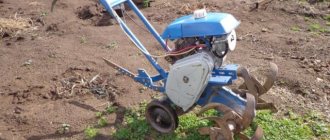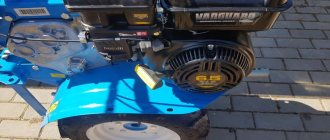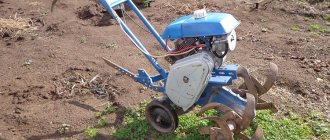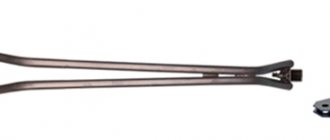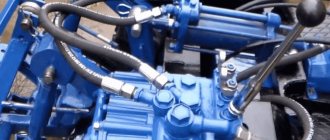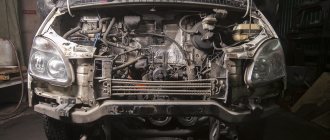Possible malfunctions, repairs
Despite the simplicity of their design, Krot motor cultivators are extremely sensitive to contamination of individual components, parts, mechanisms and other components of the unit. Many problems during operation arise due to untimely replacement of consumables and neglect of basic rules for caring for equipment. The ironic slogan “Tanks are not afraid of dirt” does not work in this case.
Let's look at the most common problems and breakdowns that occur in the main components of the cultivator.
Engine
The first samples of Mole cultivators had many complaints specifically from the motors, which were unreliable and had a short service life. Equipment owners modified agricultural machines at their own risk. Often, new engines were installed on the units to replace the ones that had fallen into disrepair from other garden equipment: Forza, Patriot, Sadko, Lifan.
Thanks to factory design developments, cultivator models with engines Honda GC 120, Honda GC 135, Greenfield, GeoTeck, Subaru Robin EY-15D, Hammerman, INNOMOTOR , Briggs & Stratton from well-known Japanese, German, American, Hungarian, and Italian brands appeared.
Thanks to modern engines and innovative developments, the Mole has turned from a once narrowly functional milling cultivator into a universal agricultural machine, which is capable of performing any agricultural work on tillage, cultivating crops, as well as transporting goods and clearing territory.
Therefore, if your Mole motor cultivator still has an old two-stroke engine, urgently replace it with a new model and feel free to expand the functionality of the unit. The most budget-friendly and fairly reliable option is Lifan; “Americans” and “Japanese” will be more expensive, but subsequently they will require much less attention.
If the engine does not start:
- empty fuel tank or poor quality fuel;
- difficulty with ignition;
- consequences of decompression in the form of deformation of the exhaust valve, breakdown of piston group elements - it is necessary to disassemble the engine and replace worn-out parts.
The mole won't start!
Started up:
Ignition
The ignition may be completely absent or not fire in the following cases:
- If the magneto fails, it is replaced, since the device cannot be repaired.
- If there is no spark, the spark plug may have simply burned out; you should replace it with a new one.
- A sooty spark plug must be thoroughly cleaned and washed with gasoline.
- If there is a spark, but the equipment does not start, pay attention to the condition of the spark plug - if it is damp or wet, it means the insulation has been damaged. To eliminate the defect, it is enough to change the tip. In turn, a wet spark plug is most often caused by low-quality fuel.
- Due to excessive wetness of the spark plug and fuel leakage, there will also be no spark; you should bleed the engine using a manual starter, thereby drying the cylinder.
- Increased gap between the electrodes - it is necessary to set the optimal gap size.
- A dirty air filter is the most common cause of lack of spark, so it is necessary to systematically check its condition and change it in a timely manner.
- The integrity of the fuel line is damaged - the hoses should be replaced.
- Electrical system insulation failure.
- Check the position of the flywheel plates - they may be jamming the magnetic circuits.
Replacing the magneto in the Mole cultivator:
Operation of the Mole cultivator with a repaired ignition
Carburetor
The consistency of processes when starting the engine and its further operation depends on the correct adjustment of the carburetor. The main function of the carburetor is to create a fuel-air mixture, which, after ignition, powers the heart of the cultivator - the motor. Therefore, it is extremely important to adjust it in accordance with the recommendations of the factory instructions. The carburetor requires adjustment after the first season of operation.
The adjustment consists of setting a consistent fuel supply and the required speed. The speed and fuel quality screws are used to make the necessary adjustments to the carburetor in idle mode. In addition, it is important to keep the carburetor clean at all times.
Another reason that the Mole motor-cultivator does not start, especially after long periods of inactivity, may be the appearance of condensation in the carburetor due to temperature changes. In this case, you will have to completely disassemble the carburetor and clean it. Due to poor quality fuel, the carburetor may also not work efficiently.
How to replace the engine yourself
Replacing a low-power motor can significantly expand the capabilities of a motor cultivator. Low power is not the only disadvantage of the engine that the domestic manufacturer equips Krot cultivators with.
The open design leads to severe contamination of the unit. Dust and dirt accumulate in filters and hard-to-reach places, leading to overheating and engine malfunction.
Other disadvantages of the engine installed on the Mole by the manufacturer:
- availability of only one operating speed;
- short service life - up to 400 engine hours;
- failure of the piston group after 1-2 years.
If a choice is made, installation and start-up of the new engine is carried out strictly according to the instructions. How to install another motor on the Mole walk-behind tractor:
- Unscrew the factory fasteners.
- Remove the wires through which starting and silencing are carried out.
- Remove the motor.
- Take the new unit and attach it to the frame. Mark the places where you will need to make mounting holes.
- Place the engine on the frame and put a belt on it. Then move the unit along the frame until you achieve maximum tension. In this case, both pulleys - the motor and the gearbox - must be located in the same plane.
- Screw the engine to the frame.
- Connect the transmission.
- Run the engine idle.
After installing a new motor, it is necessary to run it in. To do this you will have to use two full tanks of fuel. This is necessary for further operation of the unit. You cannot work on a new engine right away.
The Partner company is a well-known Swedish manufacturer with a long history. It brings to the market a huge range of...
If your fleet of equipment has been replenished with the Krot cultivator, but its performance does not meet your requirements, you can make adjustments to its design. To significantly expand the capabilities of the walk-behind tractor, change the engine to a more powerful unit, and you will be able to perform large volumes of work in less time.
Source
Description
The “Mole” motor-cultivator appeared in the early 80s of the last century and immediately gained popularity among rural residents and dacha owners. This is not surprising, because with the help of this agricultural technology, mechanized soil cultivation, as well as planting, care and harvesting, became possible.
Over more than 30 years of its existence, “Mole” has been modified more than once. Such parts as the engine, gearbox, handles, cutters, as well as other equipment (including attachments) were brought to perfection. Having gone through a difficult path of improvements, we no longer received the original motor cultivator, which has some limitations in operation, but a multifunctional motorized device, with which we can easily carry out the following field work:
- plowing the soil;
- cutting beds;
- planting potatoes;
- spud of plants;
- weeding plants from weeds;
- mechanized potato harvesting;
- mowing;
- irrigation;
- transportation of bulk and piece goods;
- snow removal.
In order to perform all of the above work, you need to acquire the appropriate tools. You can find out more in the article about attachments for the Mole cultivator on our website.
No matter how powerful your unit is, no matter how much you care for it, sometimes it still requires repair - the engine won’t start, the engine gets hot, or some other malfunction... To know how to repair a motor cultivator, you need to understand its structure.
What motors are suitable for installation on the Mole cultivator?
Among the suitable engines for most Mole units, the following models stand out:
Motor Lifan 168 FB
Power 6.5 l. With. with a 2 cm pulley shaft. Some configurations have a shaft 1.9 cm long.
The engine air filter should be equipped with an oil bath, which helps reduce the load on the engine in dusty areas.
Imported engine Sadko DE-220, 4.2 liters. With.
The shaft diameter of this motor is 1.9 cm, and the motor is started using a cord.
Patriot electric motor, 7 hp. With.
It is also quite reliable, but there must be an uninterruptible power supply source located near the site.
Each of these motors fits well into the cultivator design, and installation of the device will require a minimum of frame modifications.
Common breakdowns
What machine elements may require the operator's close attention?
Let's list them:
- motor;
- magneto, ignition system;
- carburetor;
- gearbox;
- air filter, etc.
Now let’s take a closer look at all those malfunctions that can affect the performance of the unit, no matter what model it belongs to.
Does not start
So, what to do if the “Mole” does not start, what could be the reasons for this? The ignition fails or there is no ignition at all in the following cases:
- No spark. This could mean the spark plug is burnt out. In this case, you need to unscrew it and simply replace it with a new working one.
- The spark plug is smoked. A good cleaning will bring it back to life (remove carbon deposits, clean the contact), after which the spark plug must be thoroughly rinsed in gasoline.
- If the cultivator does not start, but there is a spark, then most likely the reason is a lack of insulation. We look at the candle again, in this case it is wet or slightly damp. You don't have to change the entire spark plug; you only need to replace the tip.
- Poor quality fuel may cause the cultivator to fail to ignite. It is for this reason that the spark gets wet, after which you will have to change the tip.
- Fuel dripping from the spark plug is another reason why the car will not start. To rectify the situation, it is necessary to drain the cylinder by bleeding the engine using a manual starter.
- The reason for the lack of ignition may also be problems with the fuel supply hoses. To restore the operation of the cultivator, it is necessary either to properly tighten the hoses, or, in case of rupture, replace them with new ones.
- Poor insulation of the electrical system (high and low voltage wires) can also cause the unit to not start.
- Pay attention to the air filter. If it is dirty, then problems with ignition are guaranteed. It needs to be either cleaned or replaced. Most often they resort to the second option, fortunately, this spare part is available both in price and in availability in the store.
- Failure of the magneto itself. This part cannot be repaired and is immediately replaced with a new one. How to check the magneto of the “Mole” motor-cultivator to make sure it is faulty? Yes, it’s very simple - if all the reasons why there may be no spark are excluded, then the cause of the malfunction is in the magneto. Many craftsmen rework the working magneto, thereby increasing its service life.
This is what the Magneto ignition circuit for the “Mole” motor cultivator might look like
- There may be no ignition if the flywheel plates jam the magneto cores.
- An incorrectly set gap between the electrodes will not allow a spark to escape.
Video review of the modernization of the ignition of the “Mole” motor cultivator
As you have seen, setting the ignition is not so difficult.
Engine
The main reasons that the “Mole” engine does not start are:
- lack of fuel (or its low quality);
- ignition problems discussed above;
- the appearance of decompression and, as a result, piston wear and deformation of the exhaust valve.
In the first case, it is enough to simply fill in the required amount of fuel (a mixture of gasoline with M-8V autolom oil) and all problems will be resolved. In the case of a compression failure, you will have to completely disassemble the engine and replace damaged parts, and this could be a piston or an o-ring.
Deformation of the exhaust valve becomes another cause of compression failure, which leads first to a loss of power of the “Mole” motor-cultivator, and then to starting problems.
To restore engine functionality, it is necessary to completely disassemble it. Having assessed the condition of the piston, replace it if necessary. We change the piston rings and exhaust valve. We examine the engine head, in particular the gas distribution mechanism, and if there is carbon deposits, we clean it. If structural elements are damaged, we replace them with serviceable ones.
Motor selection
During the Soviet Union, only domestically produced two-stroke single-piston engines were used, which were not particularly powerful. Today you can find “Mole” with a four-stroke imported engine. But if you still have the first model of a cultivator in your arsenal, then upgrading your “Mole” by replacing the motor is not at all difficult.
And here a new question arises: which engine is better to install on the unit? It’s not difficult to answer - those models that are installed in newer cars are suitable.
It is best to replace the domestic engine with an imported one:
Any of them will not only give the motor-cultivator a new life, but will also significantly increase the power and service life of the unit.
An excellent solution would be to install the Lifan engine on the “Mole” motor-cultivator. Such a motor provides the car with a long life, because in addition to reliability and efficiency, Lifans also stand out for their unpretentiousness and definitely do not require additional attention.
Video review of replacing the engine on a Lifan 168 F-2 with a Mole cultivator
Carburetor
What is a carburetor and why do you need to adjust it? A carburetor is a small device designed to produce a fuel-air mixture. This mixture, with the help of a piston and a spark plug, will be maximally compressed and ignited, and the engine will start and continue to operate.
Carburetor adjustment must be carried out after the first working season.
Carburetor adjustment is one of the mandatory points included in the “maintenance” section of the unit. Thanks to timely inspection and repair, the service life of the cultivator will increase. In addition, inspection and adjustment are also necessary when the engine roars strongly for no apparent reason.
Before we start setting up, we need to familiarize ourselves with the design of the carburetor of the “Mole” cultivator:
So, to debug the fuel supply and ensure the required speed, you need to turn to two screws: the number of revolutions (in Fig.) and the quality of the fuel (Fig. ). Using these two screws, we adjust the fuel supply to the carburetor of the “Mole” motor-cultivator at idle speed. You must act very carefully; first check the state of the ignition.
Important! Thoroughly clean the carburetor, where necessary - strip it, wash it, where necessary - change parts. Then the Mole motor cultivator will serve you for a very long time.
Owners of the unit are often interested in how to start the “Mole” cultivator after winter. The reason for the lack of ignition is condensation in the carburetor that has accumulated during inactivity at changing temperatures. Complete disassembly of the device and further cleaning will help solve this problem. All kinds of additives found in low-quality fuel and dust that has seeped through the filter will also not contribute to the operation of the device.
Gearbox
The main task of the gearbox is to transmit torque from the engine to the shaft. The transmission of motion is carried out using a V-belt transmission. You can learn more about the design and repair of the gearbox of the “Mole” motor-cultivator by watching the video.
Video review of the Mole motor-cultivator gearbox
Reverse
The first modifications of the “Mole” are not equipped with a reverse function (reverse speed), which somewhat affected their performance characteristics and ease of working with such attachments as a cart, snow blower, mower, etc. To modify the “Mole”, the manufacturer released new modifications of it , already with a reverse function, which significantly increased the mobility of the cultivator.
Video review of the reverse function on the Mole motor-cultivator
Drive belt
The drive belt transmits torque from the engine to the gearbox. The cause of breakdown of the “Mole” motor-cultivator is often a rupture of the drive belt. This occurs due to the belt jamming during operation due to heavy loads on the working parts of the cultivator (hard soils, blunt cutters). The cutter bends and catches the belt with the knife, thereby rendering it unusable.
Drive belts for the “Mole” cultivator can have various modifications, but their dimensions are strictly defined:
How does a walk-behind tractor work?
The domestic walk-behind tractor has a rational design - there is nothing superfluous in it. At the same time, the cultivator can be equipped with attachments that allow it to be used for a variety of economic purposes. The equipment is reliable and can withstand long-term loads.
Components of the design:
- A frame consisting of two half-frames and attached to the gearbox with bolts.
- Tubular handle and bracket - for placing attachments.
- Control levers. The handle is equipped with controls - you can switch the clutch and engine speed. Some Krot models are equipped with an additional reverse switch.
- Pneumatic wheels attached to the output shafts of the gearbox.
- Two-stroke single-cylinder engine. The cooling system is air. The engine is attached to the frame, it is connected to the gear shaft using a V-belt type transmission.
- The walk-behind tractor is equipped with cutters - two external and two internal. A coulter is also included. If necessary, it is equipped with a hiller, potato digger, plow, pump, and mower.
Features of the Mole design:
- A V-belt transmission connects the engine for the Mole walk-behind tractor and the gear reducer to each other. The latter has a chain drive and is secured to the frame with bolts. A fuel tank is located above the motor and gearbox.
- To change the clutch, the mini-tractor has a special handle - the same as on mopeds. The clutch is in the disengaged state; when it is turned on, the belt is tensioned and torque is transmitted without slipping.
- On the output shafts of the gearbox there are working cutters, which are used to cultivate the soil, or wheels - they are needed for transporting goods and for plowing the soil with a plow. A milling cutter is a rotor with special knives that, rotating and moving forward, cut and crumble the soil.
The cultivator is equipped with built-in wheels for moving. Before starting work, they are dismantled or, lifted, fixed in the desired position. Run-in is carried out for 15 hours, giving partial load.
- weight (empty tank) – 51.5 kg;
- processing width – 40-60 cm;
- rotor diameter (including knives) – 32 cm;
- insertion depth – 25 cm;
- dimensions (LxWxH) – 100-130x35-80x71-106 cm;
- productivity – up to 200 sq. m/h.
Maintenance
What does maintenance mean? This is a series of measures that ensure proper operation and proper storage of equipment. Maintenance of the “Mole” cultivator means the following work:
- washing;
- cleaning;
- lubricant;
- control;
- gas station;
- control;
- fasteners;
- adjustment of all blocks and systems
Such work must be done as often as possible, especially if you have to work in unfavorable conditions.
Before starting the cultivator engine, it is necessary to check the presence of fuel, oil, etc. It is necessary to fill the mixture to a certain level, and if necessary, replace the fuel and oil. For cultivators, Avtol oil (M-8V) is used, which proved itself during the Soviet Union.
If it is difficult to get it, then you can use analogues:
- 10W-30 (do not use at temperatures above +27 degrees);
- SAE 30 (do not use at temperatures below +4 degrees).
Adjustment work involves adjusting the clutch, reverse gear, carburetor, spark, etc.
Cleaning work includes cleaning the filter, working surfaces, housing and all clogged parts on the surface of the Mole motor-cultivator. If malfunctions occur, or for preventive purposes (less often), it is necessary to clean the internal parts of the machine.
Before putting any part back in its original place, make sure it is in good working order.
Installation or replacement of any attachments must be carried out with the engine completely turned off. When preparing for long-term storage, the motor cultivator requires conservation. To do this, you need to prepare the engine in a certain way (see instructions), then clean (rinse) and dry all the external parts of the “Mole”, wipe them with a rag, drying them well. After this, you need to lubricate all accessible areas of the cultivator with grease. The unit is now ready for a long rest.
User manual
In the operating instructions supplied with the Mole walk-behind tractor, the manufacturer indicates the following information:
- setting up mechanisms and troubleshooting;
- safety rules when working with the unit;
- features of using the device;
- information about the parameters and structure of the agricultural machine.
Reliable and long-term operation of the walk-behind tractor depends on proper and regular maintenance, as well as on competent and constant care. The user needs to perform simple manipulations to care for the mechanism. In this case, the cultivator can last more than 10 years.
As fuel, you must use a mixture of AI-80 or AI-76 gasoline and M-12-TPTU or M8V1 oil.
The operation of the walk-behind tractor depends on proper and regular maintenance.
The oil level must be constantly monitored and, if necessary, replenished to the required amount. After each use of the cultivator, it is important to clean it from dirt. At the end of the procedures, the agricultural machine is wiped dry and its working units are lubricated.
First start
Correct startup of the walk-behind tractor when first used determines its future service. This process is called break-in and lasts at least 15 hours. Before and after break-in, it is important to check whether the level of working fluids corresponds to the norm and top up, if necessary, to the required amount.
Communities › DIY › Blog › mole cultivator. cry for help
Good day, homemade products. I have an old “mole” cultivator, which served faithfully for many years. approximately the same as in the picture. So lately the fuel problem has been getting more and more pressing. The fact is that the engine on it is designed to run on AI76 or AI80 gasoline, and every year it is becoming more and more difficult to find. Changing the engine is a bit expensive. Are there any ways or thoughts on how to transfer it to ai92? Maybe someone has already solved this problem? share your experience. thank you in advance.
see also
Comments 145
So there is the simplest two-stroke engine and a piston from a delta lei 92 moped, only there is more oil in gasoline and everything will be smooth. And if suddenly something happens with the pistons, it will take 30 minutes to replace it
there is a mole, Lil 92nd, the carburetor was installed Chinese from a scooter, now I bought an agate, the mole is in the garage.
I bought it for a ruble, changed the piston, seals and this is what happened
I also have a Mole, I bought it new about 8 years ago. 76 disappeared, started pouring 92 and everything was fine! You can add a little more oil. Yes, it is noisy, and ours is a domestic engine, but there were no problems other than one replaced belt.
I have one like this, last year, once again the engine gave up its life. Disassembled. The piston and cylinder are scuffed. I calculated the cost of repairs and it came out to 2,500 rubles. This is for 2 seasons. He doesn't walk any longer. I bought a Chinese 4-stroke for 5,000 rubles.
Only replacement with Lifan 160F 4 hp. or similar. The mode of operation of the device will change and the performance characteristics will also change only for the better, at one time I suffered with this two-stroke, sometimes it overheated after 15 minutes of operation, sometimes it didn’t work, I went through one place several times. Definitely the engine needs to be replaced and you will be happy.)
Do not pour 92 under any circumstances, this is DEATH... look for 76...
Do not pour 92 under any circumstances, this is DEATH... look for 76...
I had the same one, firstly, it’s a two-stroke, gasoline mixes with oil and it doesn’t care about the 92 gasoline bill! And secondly, the engine is constantly crap and blows your mind! In short, it’s easier to buy and install a Chinese one and forget all the problems.
There is only one way, to raise the coolant, but for a native two-stroke this is not advisable, my father changed the engine to a Lifanov four-stroke, 4 hp in my opinion
As I understand it, it's a two-stroke. Then he really doesn’t care what to work on, even alcohol. Only we need different jets for alcohol and a club to drive away drunks so that they don’t drink the fuel straight from their throats.
I've been using the same one for over 10 years. Whatever was at hand was poured. The last 3-4 years only 92nd.
I've been pouring 92 into it all my life and no problems.
I've had one of these since '86. I take the 80th at the gas station (when available) and the 92nd is such crap, it just sits for a week, the additives fly off and probably the 76th turns out
The original engine is shitty and rare, it has constant problems until you start it and you don’t want to work anymore. 6 years ago I threw out the original engine from the mole and installed a Chinese four-stroke Lifan 4 hp engine. gasoline 92 and forgot about the problems... minimal modifications to the engine itself. bought for 6000t
I sold this one last year!
I envy you in white. I think the mole’s two-stroke engine is “covered with a copper basin.” Served long and faithfully, eating the 92nd when the 80th disappeared from sale. I just installed a Lifan engine (four-stroke single-cylinder), so give it at least 95.
Feel free to pour 92, well, you can add a little more oil and don’t worry
All my life I have had a “Mole” and a “Neva” and a “Neptune” outboard motor running on 92. The resource will be 92 more and it works softer, the power is higher.
Neva with a St. Petersburg engine? 4 stroke?
maybe from a Moscow plant, that was a long time ago. 4 stroke
in general, 92 is not scary for him?
Yes, it is at 76 and cannot work normally. I tried it once and didn't get any more. It's a shame about the engine. since 91 works like a clock! with one ring and ignition change last year.
There are no valves, if you work at 92 nothing will happen. All Soviet two-stroke motorcycles run at 92 without any problems.
More is not less, especially since it’s not 98. We haven’t had 76 for a long time, there hasn’t been a trace of 80, everyone has switched to 92, some of them were 76 and don’t care.
We dug this up about four years ago when I bought a garage. It started up without any problems and works faithfully on 92 gasoline. Used every year
Benz has the same density, but the effect is different. Somewhere in the advice on alterations I saw that people make a mixture with kerosene - 1:10, as in their time on chainsaws. But this is, so to speak, a partial solution. If you ask yourself about the correct alteration, then: Firstly, you need to reduce the combustion chamber (program the head as much as possible) Secondly, increase the heat removal, since the combustion temperature of higher octane fuel is higher Thirdly, you need to shift the ignition to earlier (3-5 degrees, again octane number and temperature - so that it starts to burn earlier)
Does it move there?
Just add water!)))
He's been running the 92 for ten years, the flight is normal :)
I wish I could see this 92 gasoline... Based on numerous gas station inspections, the octane number of 80% of 92 gasoline barely reaches 80-82. Therefore, there is no need to worry about pouring it.
Pour 92 into the tank. The density of gasoline is the same.
My father had one, it always ran at 92 and without problems, there was some other problem with the engine, my father corrected it several times, and then he just took and installed an electric motor and a 40-meter cable)))))
I’ll tell you this, under the operating conditions of any engine, the minimum actane number of the fuel used is written. Those. Fuel with an actane number less than declared is not recommended for use; therefore, fuel with a higher actane number can be used, nothing will happen to your mechanism, it will only be better. There is no need to alter anything in it, well, maybe do the ignition a little earlier and that’s all.
In order to freely climb into the carb every spring (it’s the same thing, at first it won’t start, damn it) I moved the gas tank higher. ))) (there will be no photos). I have such a trakhtar made in Lelichy in 1989. )) It’s still running (it hasn’t been started this year yet). I changed the piston 2 times.
Fifty comments and not a single one on the case!(((The same problem with the engine from Vyatka-Electron. At work they bring 402 heads from a car to us to convert to 92. The milling machine removes about 3.2-3.5mm. This size someone derived it based on the volume of the combustion chamber and compression at 92. On single-cylinder two-stroke walk-behind tractors, the chamber volume is slightly less than on a car. To calculate exactly how much to shoot on a particular engine, you need to have data on the required compression ratio and chamber volume. The resulting volume pour liquid into the head and measure the height from the plane of the connector to the surface of the liquid. Adjust it more accurately with a compression gauge. In your case, try removing about 1.0 mm from the end of the head on a lathe. After that, check the compression, which should be on 92-octane gasoline. If necessary, Repeat the operation, removing several dozen at a time.
chamber volume 5.2-5.5 We find the formula, apply it and reduce the chamber according to the calculated data. On the Carpathian B50, 1.2 mm was shot. Subtlety of compression measurement. On a dry piston it will show one compression (less). Just lubricate the cylinder with oil and the compression will skyrocket)). The compression ratio, if memory serves, is 7-7.5 (again, in the Carpathian B50.)
On the 92nd 7.0-7.5? Most likely on the 76th.
I won’t say I don’t remember which one
Fifty comments and not a single one on the case!(((The same problem with the engine from Vyatka-Electron. At work they bring 402 heads from a car to us to convert to 92. The milling machine removes about 3.2-3.5mm. This size someone derived it based on the volume of the combustion chamber and compression at 92. On single-cylinder two-stroke walk-behind tractors, the chamber volume is slightly less than on a car. To calculate exactly how much to shoot on a particular engine, you need to have data on the required compression ratio and chamber volume. The resulting volume pour liquid into the head and measure the height from the plane of the connector to the surface of the liquid. Adjust it more accurately with a compression gauge. In your case, try removing about 1.0 mm from the end of the head on a lathe. After that, check the compression, which should be on 92-octane gasoline. If necessary, Repeat the operation, removing several dozen at a time.
Compression or compression ratio?
Fifty comments and not a single one on the case!(((The same problem with the engine from Vyatka-Electron. At work they bring 402 heads from a car to us to convert to 92. The milling machine removes about 3.2-3.5mm. This size someone derived it based on the volume of the combustion chamber and compression at 92. On single-cylinder two-stroke walk-behind tractors, the chamber volume is slightly less than on a car. To calculate exactly how much to shoot on a particular engine, you need to have data on the required compression ratio and chamber volume. The resulting volume pour liquid into the head and measure the height from the plane of the connector to the surface of the liquid. Adjust it more accurately with a compression gauge. In your case, try removing about 1.0 mm from the end of the head on a lathe. After that, check the compression, which should be on 92-octane gasoline. If necessary, Repeat the operation, removing several dozen at a time.
Do you own Vyatka?
It’s clear, a motorized winch. I thought you had the whole Vyatka, I wanted to chat.
Thank you, I am aware of this site.
Fifty comments and not a single one on the case!(((The same problem with the engine from Vyatka-Electron. At work they bring 402 heads from a car to us to convert to 92. The milling machine removes about 3.2-3.5mm. This size someone derived it based on the volume of the combustion chamber and compression at 92. On single-cylinder two-stroke walk-behind tractors, the chamber volume is slightly less than on a car. To calculate exactly how much to shoot on a particular engine, you need to have data on the required compression ratio and chamber volume. The resulting volume pour liquid into the head and measure the height from the plane of the connector to the surface of the liquid. Adjust it more accurately with a compression gauge. In your case, try removing about 1.0 mm from the end of the head on a lathe. After that, check the compression, which should be on 92-octane gasoline. If necessary, Repeat the operation, removing several dozen at a time.
I don’t remember exactly when 76 disappeared, it seems like 2-3 years ago. So there were official letters from the Gas and Zil plants indicating the procedure for switching to 92nd gasoline, somewhere at work these letters may be found. So two options were recommended! Adjustment of ignition timing on Gas-53, 3307, 3302, etc., Zil-130, 433660, etc. and the catalog numbers of parts for replacement under the 92nd were indicated (block heads, push rods, etc.). In our organization there are still plenty of Zilovs, Gazonovs, UAZs that were under 76m. They didn’t cut any of the heads, they just adjusted the ignition! What's the use of a Zilov engine with a low compression ratio of 6.5, and then everything is fine with the cylinder heads and gaskets.
Possible malfunctions, repairs
Despite the simplicity of their design, Krot motor cultivators are extremely sensitive to contamination of individual components, parts, mechanisms and other components of the unit. Many problems during operation arise due to untimely replacement of consumables and neglect of basic rules for caring for equipment. The ironic slogan “Tanks are not afraid of dirt” does not work in this case.
Let's look at the most common problems and breakdowns that occur in the main components of the cultivator.
Engine
The first samples of Mole cultivators had many complaints specifically from the motors, which were unreliable and had a short service life. Equipment owners modified agricultural machines at their own risk. Often, new engines were installed on the units to replace the ones that had fallen into disrepair from other garden equipment: Forza, Patriot, Sadko, Lifan.
Thanks to factory design developments, cultivator models with engines Honda GC 120, Honda GC 135, Greenfield, GeoTeck, Subaru Robin EY-15D, Hammerman, INNOMOTOR , Briggs & Stratton from well-known Japanese, German, American, Hungarian, and Italian brands appeared.
Thanks to modern engines and innovative developments, the Mole has turned from a once narrowly functional milling cultivator into a universal agricultural machine, which is capable of performing any agricultural work on tillage, cultivating crops, as well as transporting goods and clearing territory.
Therefore, if your Mole motor cultivator still has an old two-stroke engine, urgently replace it with a new model and feel free to expand the functionality of the unit. The most budget-friendly and fairly reliable option is Lifan; “Americans” and “Japanese” will be more expensive, but subsequently they will require much less attention.
If the engine does not start:
- empty fuel tank or poor quality fuel;
- difficulty with ignition;
- consequences of decompression in the form of deformation of the exhaust valve, breakdown of piston group elements - it is necessary to disassemble the engine and replace worn-out parts.
The mole won't start!
Started up:
Ignition
The ignition may be completely absent or not fire in the following cases:
- If the magneto fails, it is replaced, since the device cannot be repaired.
- If there is no spark, the spark plug may have simply burned out; you should replace it with a new one.
- A sooty spark plug must be thoroughly cleaned and washed with gasoline.
- If there is a spark, but the equipment does not start, pay attention to the condition of the spark plug - if it is damp or wet, it means the insulation has been damaged. To eliminate the defect, it is enough to change the tip. In turn, a wet spark plug is most often caused by low-quality fuel.
- Due to excessive wetness of the spark plug and fuel leakage, there will also be no spark; you should bleed the engine using a manual starter, thereby drying the cylinder.
- Increased gap between the electrodes - it is necessary to set the optimal gap size.
- A dirty air filter is the most common cause of lack of spark, so it is necessary to systematically check its condition and change it in a timely manner.
- The integrity of the fuel line is damaged - the hoses should be replaced.
- Electrical system insulation failure.
- Check the position of the flywheel plates - they may be jamming the magnetic circuits.
Replacing the magneto in the Mole cultivator:
Operation of the Mole cultivator with a repaired ignition
Carburetor
The consistency of processes when starting the engine and its further operation depends on the correct adjustment of the carburetor. The main function of the carburetor is to create a fuel-air mixture, which, after ignition, powers the heart of the cultivator - the motor. Therefore, it is extremely important to adjust it in accordance with the recommendations of the factory instructions. The carburetor requires adjustment after the first season of operation.
The adjustment consists of setting a consistent fuel supply and the required speed. The speed and fuel quality screws are used to make the necessary adjustments to the carburetor in idle mode. In addition, it is important to keep the carburetor clean at all times.
Another reason that the Mole motor-cultivator does not start, especially after long periods of inactivity, may be the appearance of condensation in the carburetor due to temperature changes. In this case, you will have to completely disassemble the carburetor and clean it. Due to poor quality fuel, the carburetor may also not work efficiently.
Models and their characteristics
The rapid development of modern technologies has allowed the Krot brand to launch models with wide functionality and good technical characteristics. The most popular units are the following:
- MK-1A;
- MK-3A-3;
- MK-4-03;
- MK-5-01;
- MK-9-01-02.
MK-1A
The model is the smallest in its series and is powered by a two-stroke carburetor engine with a capacity of 2.6 liters. With. There is also a modification MK-1A-02, which is a little more powerful. But even with its miniature size and low productivity, such a unit can process large areas, and the process of moving it does not require much effort.
The devices are in demand for work in greenhouses and greenhouses. They do not have a reverse gear option, so they only move forward in 1st gear. The Mole MK-1A cultivator weighs only 48 kg.
MK-3A-3
The unit is much larger than the previous one, and its weight is 51 kg. At the same time, it fits freely in the trunk of a car and is equipped with a fairly powerful GioTeck engine (3.5 hp).
Distinctive features of the model include:
- Reverse gear available.
- More advanced technical and operational characteristics that facilitate comfortable use of a gasoline or electric cultivator.
MK-4-03
The model weighs 53 kg and comes with a Briggs&Stratton engine with a power of 4 hp. The device has only 1 gear - forward. It is distinguished by improved soil gripping capabilities, which ensures high-quality agricultural work.
MK-5-01
The Mole 5 cultivator is not much different from the previous model, with the exception of a new engine from Honda with increased endurance and similar power properties. It is usually used for processing small vegetable gardens and greenhouses in the country. The motor power can be adjusted by studying the manual for using walk-behind tractors.
MK-9-01-02
It is considered a high-performance device, powered by an engine for a Mole Hammermann motor-cultivator with a power of up to 5 hp. With. Increased productivity contributes to the effective processing of heavy soils and virgin soil, and comfortable dimensions allow you to work with the unit for several hours without feeling tired.



